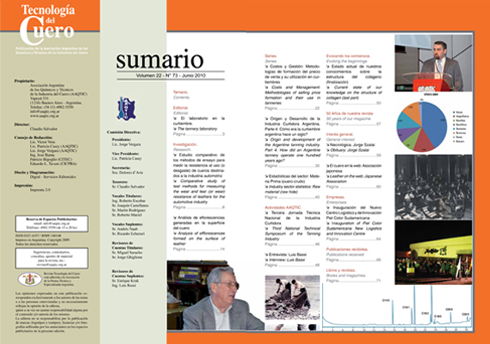Editorial
Editorial nº 73
Leather Technology Magazine

|
The tannery laboratory
This issue includes a new paper, translated from
the Japanese Association magazine, related to fat
efflorescence; a contribution that brings a source of
which only a few could take advantage – for language
reasons, of course. There is another paper related to
methods for evaluating leather abrasion, which was
presented in the Rio Conference in 2008. This was the
only Argentine oral presentation.
Moreover, this issue includes the 4th part of Tannery
History. We will stop here to consider some points:
For the last year and a half we have been reviewing
the tannery history in Argentina in our magazine.
In this issue, we will focus on what the Argentine
tannery was like a century ago. Previously, in issues
No. 70 and 71, we dealt with the Argentine tannery a
century and a half ago.
In these papers, a point that was yet unclear to many
was raised: a century and a half ago, tanneries consisted
of productive units that did not use very sophisticated
equipment, but which constituted small factories in
themselves. No machines or chemical products were
used. For a long time, tanning was based on crusts,
and then on sawdust. It was a trade, which was passed
down from father to son and had certain secrets. There
were no laboratories in tanneries, and no one conceived
that the activity could be handled by “leather chemists”
instead of “tanners” by trade.
Several factors determine the appearance of the
industrial tannery model, which is described in this
issue.
Such a tannery does make use of machines
and chemical products, does manage large-scale
productions and does apply division-of-labor ideas.
Vegetal tanning is accelerated with vegetal extracts, and
patches with chromium salts are tanned. The concept
of a “technician” that defines processes begins to exist.
In some of the publications we have cited, such as
Las Industrias del cuero en la República Argentina by
Ugarteche (1927), the existence of laboratories in some
industrial tanneries is mentioned.
However, other tanneries do not have any. This issue
includes the reproduction of the original plan of a large
tannery in 1919 that fails to have a laboratory, or at
least, nothing is called as such.
Several sources provided us with dozens of
photographs of different large tanneries at that time,
but we could only find one single photograph of a
laboratory, which illustrates the cover of this issue: the “Chemical department” of La Francia Argentina.
In the late 19th and early 20th centuries, professional
activities start to emerge in our field worldwide: in the
United States and England, meetings and Conferences are
held by “Leather Chemists” to discuss analysis methods.
Further, the first national and international Associations
are created - which eventually result in the current ones -
and publications are started: there are important milestones
such as the London Conference in 1897, the creation of
ALCA in 1903, and the publication of “Collegium” in
1902.
Leather chemists start defining their profile. They are
technicians and professionals who carry out development,
control and production management tasks in tanneries, as
well as in technical centers and chemical supply companies.
Although there have been a few changes, that idea is still
present nowadays.
The methods to deal with organization and responsibilities
in different companies may differ; but lots of medium-sized
and large tanneries are equipped with laboratories and,
during the last decade, the concept of Quality Standards
certification has also been included, involving different
organization aspects.
One of these tanneries, Curtiembres Fonseca, occupies
a relevant position with regard to this subject; their
laboratory, which is reproduced in the cover, is the
responsibility of AAQTIC Vice President, Ms. Patricia
Casey. This is a particular case: her team usually presents
papers in Congresses and Sessions. One of these papers, of
great interest to us, is reproduced in this issue.
Also in this issue, within the “Costs and Management”
series we have introduced a paper, also from the Rio
Conference, about leather pricing by tanneries, an issue
that turns out to be critical today. This series, initiated in
our previous issue, has received a warm welcome.
We have also included an article on raw materials,
together with statistical information.
The different series and sections will be alternated, since
it is not possible to include them all owing to space reasons.
Finally, some steps are being taken towards the 3rd
Session; we will try to include the papers headings in our
next issue. |



